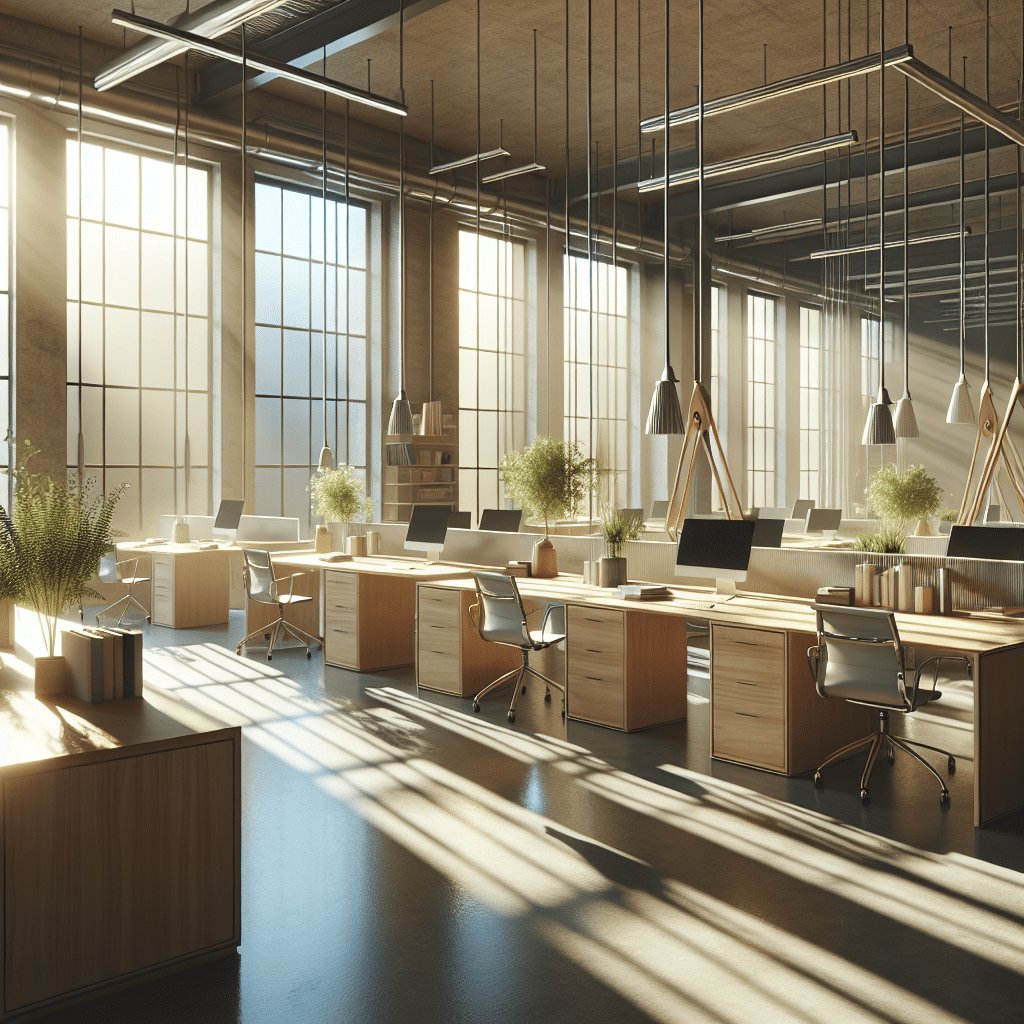Understanding Natural Light Dynamics
Maximizing natural light in your workspace can boost productivity, mood, and even health. To begin with, comprehending how natural light enters a room is essential. Windows, their size, orientation, and the landscape outside all contribute to light quality.
1. Window Orientation
Natural light varies depending on the orientation of your windows:
- South-Facing Windows: Generally, these windows receive the most sunlight throughout the day. Ideal for desk placement, especially in winter months.
- North-Facing Windows: Provide softer, diffused light. This is excellent for reducing glare and maintaining a balanced light effect, suitable for tasks requiring precision.
- East-Facing Windows: These windows bring in morning light, which is rejuvenating but fades by noon. Ideal for morning-focused work.
- West-Facing Windows: Deliver intense afternoon sunlight, which may lead to glare. Using shades can help manage the light.
Understanding the orientation of your workspace aids in planning desk placement effectively.
2. Desk Positioning
Positioning your desk optimally in relation to your windows is key. Here are techniques to create a harmonious balance:
- Perpendicular to Windows: Placing your desk perpendicular to a window allows natural light to illuminate your workspace without causing glare on your computer screen. It can also create a dynamic view while you work.
- Facing the Window: This placement invites ample light and reduces the likelihood of distractions from behind. However, be conscious of glare on your screen. Consider using anti-glare screens or adjusting your monitor’s brightness.
- Against the Wall with Window View: If space permits, positioning your desk against a wall that features a window can maximize the amount of light while allowing you to use wall-mounted shelves or organizers.
3. Using Reflective Surfaces
Maximizing light doesn’t only depend on where your desk is located. Another effective strategy includes using reflective surfaces:
- Mirrors: Placing mirrors strategically can bounce light from windows deeper into your workspace, creating a brighter ambiance.
- Light-Colored Walls: Painting your walls in light colors can help reflect and diffuse natural light, enhancing brightness in the room.
- Furniture Selection: Opting for gloss-finish furniture can also help to reflect light and make a space feel larger and more open.
4. Managing Glare
While natural light is essential, managing glare is equally important.
- Window Treatments: Choose adjustable blinds or sheer curtains to filter light without completely blocking it. This enables you to control the amount of light entering the room.
- Screen Positioning: Angle your computer screen slightly away from direct sunlight to minimize glare and eye strain.
- Anti-Glare Glass: Consider using screens or monitors that are designed to reduce glare, especially if working with computers for extended periods.
5. Seasonal Considerations
The amount of natural light changes with the seasons, influencing where you might want to place your desk:
- Winter Months: Maximize southern exposure when the sun is lower in the sky. Adjust curtains or blinds to allow as much light as possible during the day.
- Summer Months: Consider installing awnings or external shades for west-facing windows to reduce overheating from intense afternoon sun. Adjust your desk placement to ensure comfort and maintain productivity levels.
6. Utilizing Plants and Decor
Integrating plants and decor can indirectly enhance natural light in your workspace:
- Plant Placement: Strategically position plants where they won’t block light but can benefit from it. Look for plants that thrive in indirect light, naturally purifying the air.
- Decor Choices: Use light-colored décor items that reflect natural light, such as light-toned rugs or throw pillows. These elements can brighten the space while adding personal touches.
7. Avoiding Obstacles
Be aware of potential obstructions that could hinder your access to natural light:
- Furniture Layout: Avoid bulky furniture blocking windows. Organize your workspace with minimal distractions to maintain a clear path for light.
- External Barriers: If your office is surrounded by tall trees or buildings, repositioning your desk to capture the best available light might be necessary. Identify the times of day when the light is optimal and adjust accordingly.
8. Implementing Smart Technology
With advancements in smart technology, you can optimize your workspace further:
- Smart Window Treatments: Automated blinds can open or close according to the time of day or based on the sun’s position, optimizing natural light levels throughout the day.
- Light Sensors: This technology can help monitor indoor light levels, prompting when to adjust artificial lighting in the absence of natural light.
9. Creating Zones
Setting up different zones in your workspace can help in managing both light and productivity:
- Work Zone: Position your primary desk in the area of most natural light. This should be the focus point for tasks requiring concentration.
- Relaxation Zone: Create a lounging area near a window where you can take breaks. This allows for natural light exposure without the intensity required for focused work.
10. Experimentation and Personalization
Lastly, finding the optimal desk placement is often a personal journey:
- Try Different Layouts: Don’t hesitate to experiment with your desk’s location. Spend time at each setup to determine what works best for your workflow.
- Personal Preferences: Consider your working style. If you prefer quiet reflection or a lively atmosphere, adjust the desk orientation to fit this preference.
Implementing these techniques for optimal desk placement will not only enhance your workspace but can also lead to greater productivity, improved mood, and a more enjoyable work environment. Each strategy offers various benefits, and combining them can create a workspace tailored to your needs.
